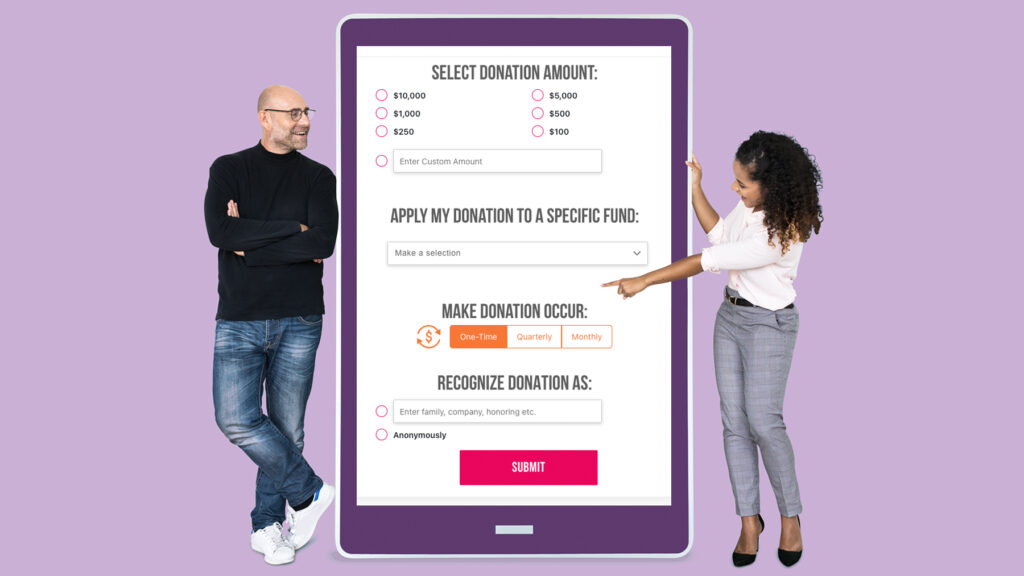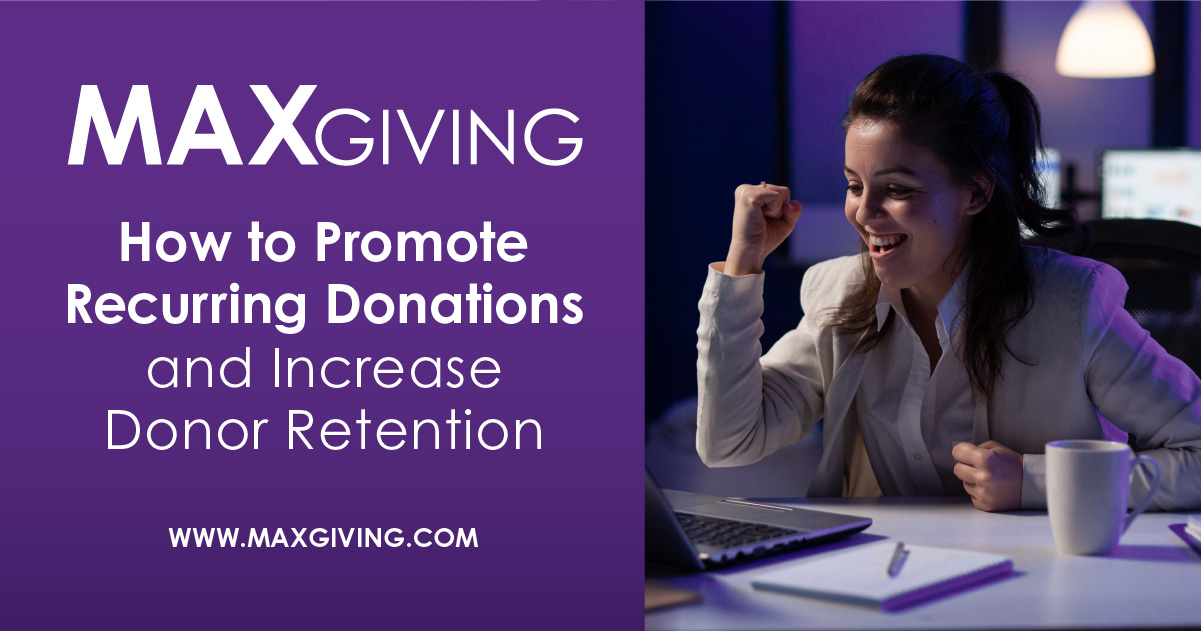Fundraising events and giving days are incredibly effective tools for your nonprofit and can bring in considerable revenue. However, most nonprofits are driven by small, monthly or yearly donations from donors who are genuinely loyal to the cause. Yes, the hype and excitement of fundraising campaigns, goal thermometers, and auction events can push your yearly donation goals over the finish line, but your recurring givers ran the race.
If you’re looking for ways to increase fundraising efforts and build donor retention, consider implementing recurring giving into your fundraising strategy.
What is recurring giving?
Recurring gifts are donations that are made on a monthly or yearly basis, typically via credit card. This type of giving allows donors to make a larger impact with their donation by committing to give over an extended period of time. According to Nonprofit Source, 45% of donors are enrolled in a monthly giving program.
Recurring giving is especially important for nonprofits because it provides a reliable source of income that can be used to sustain programs and services. Here are just a few other benefits of this unique (and effective) donation strategy.
Benefits of recurring giving (for donors and the cause)
Increased revenue
Research shows that donors who set up recurring donations give 42% more annually, compared to one-time donations. Recurring donations are a great way to increase your nonprofit’s revenue. Plus, the donations are spread throughout the year rather than just a few large fundraising events or giving days — providing a steady revenue to support the cause in the slow seasons.
Offers a convenient option for donors
Life gets busy and unfortunately, charitable giving is often one of the first things to go on the back burner. Recurring giving offers donors an easy, hassle-free way to continue donating to your non-profit — without pressing that donation button each month.
The modern world runs on subscription-like services. Many people are more likely (and more able) to donate a small monthly amount rather than a large sum all at once. According to studies, 52% of Millennials are more likely to give monthly over a large one-time donation. It isn’t just the younger generation, either! Boomers are also more likely to make recurring donations on a monthly, quarterly, or yearly basis.

Allows for long-term planning
Recurring giving is a fantastic way to provide long-term stability for your nonprofit. When people sign up to give a fixed amount each month (or year), you can budget more effectively and better know how much money you’ll have coming in.
Lowers operating costs
When it comes to fundraising, nonprofits can often find themselves caught in a bit of a Catch-22. On the one hand, you need to raise money to keep the doors open and fund your programs. On the other hand, fundraising can be expensive – especially if you’re relying on traditional methods like mailing lists and events.
Recurring gifts can help you save on fundraising costs. Because you don’t have to cultivate new donors constantly, you can focus your fundraising efforts on other activities, like building relationships with existing donors or planning fundraising events.
Improves donor loyalty and retention
Of course, fundraising isn’t all about money. It’s also about building relationships with your donors. And what better way to do that than by making it easy for them to support your work regularly? Recurring donors tend to be more loyal and committed than one-time givers, so you can build deeper relationships that span many years.
These donors start to feel like part of the family and will become partners in your cause — posting about your nonprofit on their social media accounts and telling their friends and family about the great work your organization accomplishes. They are not only making a financial investment but an emotional one as well. Recurring donors are the heart and soul of an organization, acting as key spokespeople for your nonprofit.
How to encourage donors to establish recurring giving
Clearly communicate the benefits of recurring giving to potential donors. Make it obvious how and why their monthly or yearly donation makes an impact. When donors know what their gift is being used for and how it makes a difference, they are more likely to commit to long-term giving. Include a video on your fundraising page and social media platforms explaining what a difference recurring donations make to your nonprofit.
Make it easy for donors to sign up for your monthly giving program. Use a software platform like MaxGiving to set up a donation page where donors can select how much and how often they want to give. This platform makes online recurring giving automatic so donors don’t have to remember to write a check or send in a donation.
Consider offering incentives for donors who give on a monthly basis. One great way to encourage recurring donations is to offer incentives for setting up a recurring donation schedule. For example, you could offer a discount on merchandise or services or even enter donors into a contest for a chance to win a prize.
You could even offer a small monthly gift, such as a sticker, to demonstrate your appreciation. Bring donors into special “exclusive” insider email lists where they can feel like a part of the community and stay engaged with your mission. By offering these types of incentives, you can show your donors that you appreciate their continued support.
Say thank you. When donors contribute a one-time gift, make sure you thank them and send a follow-up email offering the option to become a recurring giver. You should also send out regular thank-you messages to your recurring givers. This can help them feel valued and encourage them to continue their partnership with your organization.
A simple message goes a long way! Here is an example of a thank-you note to send to your recurring givers:
Thank you for your ongoing support! Our monthly donors are the bedrock of our fundraising efforts, and we are so grateful to have you as part of our community. Your recurring gift makes it possible for us to plan ahead and dream big, knowing that we have your generous support month after month.

How to set up recurring giving
First, make sure your donation forms are set up to accept recurring gifts. You’ll need to have a way for donors to select how often they’d like to give and the option to cancel or change their donation at any time.
There are many ways to accept recurring donations online. One popular method is to use a fundraising platform like MaxGiving, which makes it easy for donors to set up and manage their recurring donations. MaxGiving also allows nonprofits to track and manage their donations, which is essential for reporting and budgeting purposes.
Start small by offering recurring giving as an option on all of your fundraiser and event donations. Eventually, you can establish a campaign solely for recruiting recurring donors.
Next steps
Incorporating recurring giving into your fundraising strategy is an excellent way to grow your nonprofit, increase your revenue, and develop a team of committed donors who truly desire to make a difference.
Encourage your supporters to sign up for a regular donation schedule, keep them updated on your fundraising goals, and let them know how their gifts are making a difference. By showing your donors that you appreciate their support, you’ll be more likely to keep them as loyal, recurring donors for years to come.
If you’re looking for a fundraising solution that will allow you to accept recurring donations, MaxGiving is a great option. With this easy-to-use platform, you can set up recurring giving in no time. Plus, it offers powerful fundraising tools to help you reach your fundraising goals. So why wait? Start using MaxGiving today and take your fundraising to the next level!


